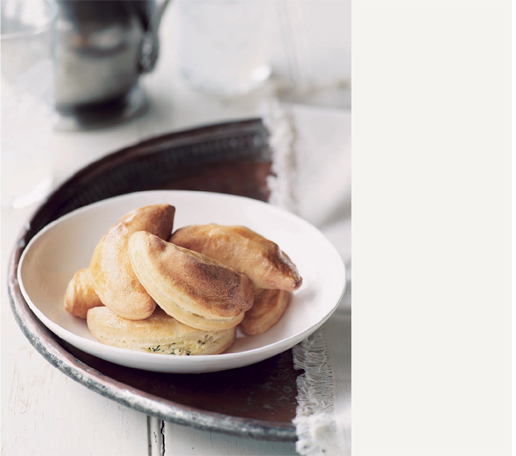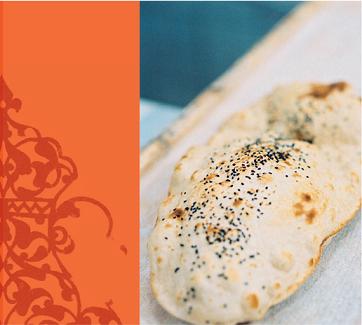
[ DUMPLINGS, BREADS AND PASTRIES ]

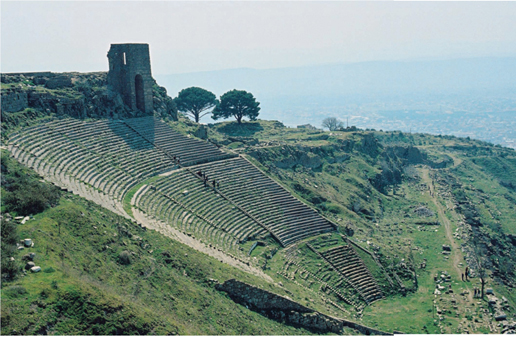
The spectacularly sited amphitheatre unfolds fanlike in the steep slope of the hillside. We perched ourselves at the top and gazed out at the view, feeling just a bit dizzy in the midday sun.
We left Ayvalik in the cool early morning, bound for Bergama and the ruins of ancient Pergamum. On either side of the main road, gently rolling hills were thickly covered with olive trees, their leaves flashing silver-grey in the light breeze. As in ancient times, the olive makes a significant contribution to the local economy: around three-quarters of the region’s farming land is used for the cultivation of close to two million trees. In fact, Ayvalik is known throughout Turkey as the olive capital and renowned for the excellent quality of its oil.
As we sped further south, the landscape began to change. The hillsides became rockier, the vegetation more sparse and olive trees gave way to groves of cypress and pine trees. It wasn’t long before we turned off the highway, heading inland towards the small modern town of Bergama, and, beyond it, the massive peak that rises up more than 300 metres from the plain.
Of all the ancient cities that are scattered along Turkey’s western shores, Pergamum surely has the pick of the sites, with its dramatic views of the surrounding countryside and the glittering Aegean Sea in the distance. According to Homer, Pergamum was such an excellent lookout that Zeus popped over from Mount Olympus to check out the action in the nearby Trojan wars.
Archaeologists believe that the site was settled as early as the eighth century BC, but Pergamum’s golden years were in the third and second centuries BC, when it was one of the most powerful and richest city-states in Asia Minor, rivalling Athens and Alexandria as a cultural centre. Not much remains of Pergamum’s former greatness and glories, it must be said, but we spent a happy few hours clambering among the ruins and taking in the expansive view. By Roman times, the city had a population of more than 300,000, and helpful posters around the site show that it was laid out in a strictly hierarchical manner. Palaces and temples enjoyed pole position on the peak, and government buildings, shops and houses spread out further down the hillside.

We wandered over to the spot where the massive altar to Zeus, with its famous frieze depicting the battle between the gods and the giants, once stood. The remains of the altar itself have been transported to Berlin as a kind of reward to the German archaeologists who were responsible for much of Pergamum’s excavation. The altar has been reconstructed in the Berlin Museum and there were more helpful posters showing us how splendid it looks in its new location.
Pergamum is perhaps best remembered for its magnificent library, built by Eumenes II in the second century BC. The library reputedly held 200,000 volumes, a clear sign of Eumenes’ pretensions to cultural grandeur. Legend tells us that the quality of the Pergamum library was viewed by Ptolemy of Egypt as such a threat to his own great library at Alexandria that he cut off the export supply of papyrus from the Nile. As a result, the ancient method of using animal skins to write on was revived and refined in Pergamum. It was known as ‘pergaminus’ – pergamum paper – from which the English word parchment originated.
A little way down the hill past the library ruins is the spectacularly sited amphitheatre, unfolding fanlike in the steep slope of the hillside. We perched ourselves at the top of its eighty-odd rows of stone seats and gazed out at the view, feeling just a bit dizzy in the midday sun.
The car park was filling up fast with tourist buses, which seemed a sign for us to head off for lunch. Dodging the attention of the ice-cream vendors near the ticket office, we pointed the car down the hill and manoeuvred our way carefully along the steeply winding road back to Bergama.
After our exertions clambering around the hilly ruins, we felt the need for something substantial; however, the guide books were worryingly silent on the subject of Bergama’s eating establishments. But a short while later, seated in a clean and tidy restaurant, we were tucking into generous bowls of manti dumplings.

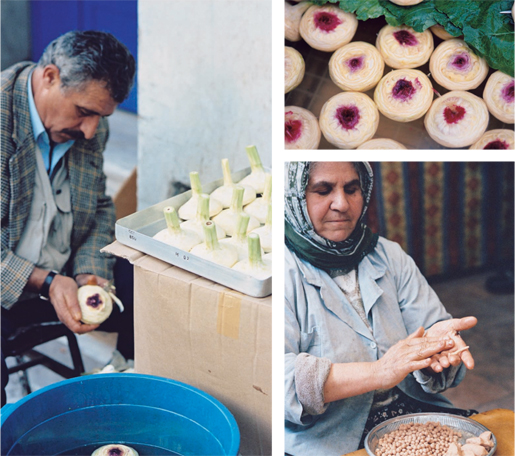

We’d been quite surprised to discover that pasta is such a feature of Turkish restaurant menus, but a little research had revealed that manti is one of the original dishes of the steppes, dating back, in all likelihood, to the nomadic Uyghur Turks in the mid-eighth century. The Uyghurs were strongly influenced by the culture of Northern China, and the same tradition of stuffing little dumplings can be seen in both cuisines to this day.
The Turks brought manti with them when they migrated west into Anatolia, and although they’re generally considered a specialty of eastern and southern Turkey, they now feature widely on restaurant menus around the country. The very best manti are homemade, the pasta dough slippery and soft under a creamy blanket of garlicky yoghurt. This version was a little on the chewy side, but on the surface of the yoghurt was a delicious swirl of sizzling butter, spiked with dried mint.
Thus fortified we decided to walk off a few calories at Pergamum’s other major attraction, the Asklepieum, on the outskirts of Bergama. The Asklepieum was a kind of ancient health-spa, catering to stressed Roman officials and gladiators in need of a spot of pampering or purging. Much like today’s spas, treatments included mud baths, mineral springs, massage and dietary advice, and even a spot of dream analysis.

The very best manti are homemade, the pasta dough slippery and soft under a creamy blanket of garlicky yoghurt.
The Asklepieum became world famous in the second century, largely thanks to Galen – the wonder doctor of his time. Physician to the stars, he treated gladiators and emperors, and more importantly made a significant contribution to modern-day medicine with his theories about the human circulatory and nervous systems.
Like visitors to this famous health centre two millennia ago, we wandered down the broad colonnaded street towards the grand entrance foyer. Off an open forecourt were treatment rooms, a medical library, a temple to Asklepios, the god of healing, and a handsome amphitheatre where waiting patients were entertained by plays and gladiatorial wrestling matches – the modern-day equivalent of the waiting-room television set.
We seemed to be the only visitors to the Asklepieum that afternoon and all was peaceful as we ambled past the sacred well, easily resisting the temptation to sip from its scummy waters. We paused for a moment in the sunshine; a few basking lizards scuttled out of sight under a fallen column and a small tortoise lumbered its way slowly through the daisies. Around us the grass was splattered with red poppies.
Making our way back along the colonnaded bazaar to the car park, we passed a cluster of souvenir stands and juice vendors offering freshly squeezed pomegranate juice. ‘Madam! Please madam! Have you had your vitamin C today?’ they entreated. Our eyes were drawn upwards to the Pergamum acropolis, high on the hillside. The white marble ruins gleamed in the sunlight and we couldn’t help but think that in its golden years this would have been a pretty good place to live.



Manti in yoghurt with sizzling paprika butter
We spent a fascinating afternoon in Istanbul with Turkish food journalist Engin Akin, who showed us how to make the silky, soft dough that’s used to make manti, a sort of Turkish ravioli. We watched, fascinated, as Engin and her helpers made the tiny dumplings. ‘The smaller the better,’ Engin said. ‘Although, really, it’s a sort of snob thing to make them so tiny!’ We enjoyed the results for lunch in a traditional garlic-laden yoghurt sauce drizzled with sizzling butter.
While Turkish women deftly roll the dough into paper-thin fineness, if you have a pasta machine at home feel free to use it. Just work the dough through each setting until you reach the finest one. When made correctly, manti dumplings are around the size of a grape, and it takes great patience and dexterity to shape and seal them with the traditional finish – but it’s worth having a go!
200 g minced lamb
1 small onion, grated sea salt
freshly ground black pepper
3 cloves garlic
400 g thick natural yoghurt
40 g unsalted butter
½ teaspoon hot paprika
½ teaspoon dried mint
MANTI DOUGH
250 g strong bread flour
2–3 large free-range eggs
1 teaspoon sea salt
To make the manti dough, lightly beat two of the eggs, then put these into the bowl of an electric mixer with the flour and salt. Use the dough hook to work it to a stiff dough – if the dough is too stiff, add the remaining egg, lightly beaten. Knead for about 5 minutes, then tip the dough onto a lightly floured work surface and knead by hand for a further 5 minutes or so until smooth and elastic. Place the dough in a lightly oiled bowl, then cover with plastic wrap and leave to rest for about 1 hour.
Divide the dough into pieces the size of a golf ball. Working with one piece at a time, roll the dough on a lightly floured work surface to form a large, paper-thin rectangle. Cut into strips around 4 cm wide. Repeat with the remaining dough. Stack the strips on top of each other and cut into 4 cm squares. (If you have a pasta machine, roll the dough through the settings, then trim the sheets to end up with 4 cm squares.)
Combine the lamb and onion in a bowl, then season with salt and pepper. Place a chickpea-sized amount of filling in the centre of each manti square.
If you’re brave enough to attempt the traditional shape, bring two opposite corners together over the filling and press to join at the top. Repeat with the other two corners, carefully moistening and pinching the side ‘seams’ as you go to seal them. You should aim to end up with a four-cornered star-like shape. For an easier option, simply moisten the edges with a little water and fold the pastry over the filling to create little triangles, then squeeze to seal. Whichever shape you decide to make, ensure that the edges are sealed well so the filling doesn’t come out as the manti cook. Place the manti on a lightly floured tray as you complete them and repeat until all the dough and filling has been used.
Crush the garlic with 1 teaspoon salt, then beat into the yoghurt until well combined.
Bring a large saucepan of salted water to the boil. Drop in around half the manti – they will rise to the surface within 1½–2 minutes as they are cooked. Use a large slotted spoon to transfer the cooked manti to four warmed serving bowls. Repeat with the remaining manti.
Spoon the garlic yoghurt sauce over the warm manti. Quickly sizzle the butter in a small frying pan, then add the paprika and mint and heat until foaming. Swirl the sizzling butter over the manti and serve straight away.
SERVES 4
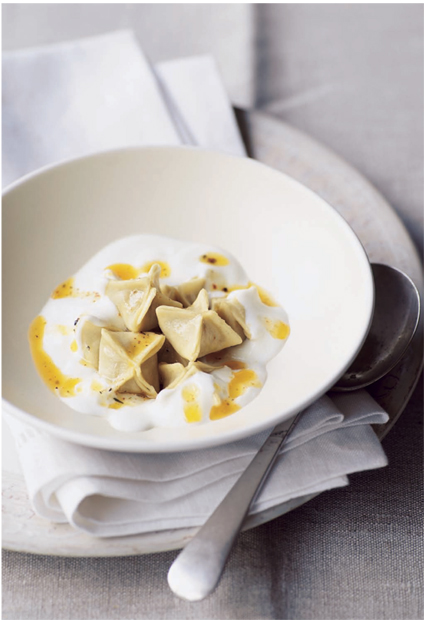
Shellfish manti – Turkish ravioli in a crab and saffron broth
If you make your own pasta it’s well worth having a go at making manti traditionally. It’s up to you whether you go all the way and learn how to produce the tiny, pleated dumplings as well. On the other hand, gyoza dumpling wrappers make a good substitute and are readily available from Asian grocers.
24 round gyoza wrappers or
1 quantity Manti Dough
800 ml Crab Stock
sea salt
2 tablespoons extra-virgin olive oil
¼ teaspoon sweet paprika
pinch of hot paprika
flat-leaf parsley leaves, shredded, to garnish
SEAFOOD STUFFING
300 g raw prawn meat, finely chopped
100 g raw crab meat, finely chopped
1 tablespoon chopped mint leaves
2 tablespoons chopped dill
½ teaspoon dried mint
1 long green chilli, seeded and finely chopped
finely grated zest of 1 lime
2 hard-boiled free-range eggs, roughly chopped
1 tablespoon extra-virgin olive oil
drizzle of honey
sea salt
freshly ground black pepper
To make the stuffing, combine all the ingredients in a large bowl. Refrigerate for 30 minutes to chill thoroughly.
To make the manti, put a teaspoon of filling into the centre of each gyoza wrapper. Moisten the edges with a little water and fold over to make a half-moon shape. Use your fingers to press the edges together and seal well.
Bring the stock to a simmer in a large, heavy-based saucepan. Taste and adjust the seasoning by adding salt, if required. Reduce the heat to keep the stock at a very gentle simmer. Bring another large saucepan of salted water to the boil. Add the manti to the water and poach for 4–5 minutes or until they are cooked and rise to the surface. Use a large slotted spoon to lift them out to drain in a colander.
Meanwhile, gently heat the oil and two paprikas to blood temperature in a small saucepan. Tip the bright-red oil into a small tea strainer lined with kitchen paper over a small bowl.
To serve, ladle the stock into four warmed bowls. Divide the manti between the bowls and drizzle with a little of the paprika oil. Garnish with parsley and serve straight away.
SERVES 4
Soft simit
‘Simiiiit!’ The sight and sound of the simitçi – simit vendor – will be familiar to nearly all visitors to Turkey. His first round is in the morning, as he weaves his way through the streets pushing his simit cart or carrying a tray of the warm, sesame-encrusted bread rings on the top of his head. He’ll be out again later in the day with a freshly baked batch, tempting shoppers with an afternoon snack.
No Turk in their right mind would ever dream of making their own simit at home. For a start they’re just too readily available, and they take many long hours of proving. So instead, here’s a recipe for a simpler version. These are almost scone-like, with a crisp shell and a slightly sweet, soft and moist interior. Simit are quite irresistible hot from the oven, spread liberally with butter and jam and enjoyed as an afternoon tea treat.
Simit are often distinctively flavoured with mahleb (ground cherry kernals), but you can omit this if you can’t find it in your closest Middle Eastern food store.
1 teaspoon dried yeast
heaped ¼ cup caster sugar
around 120 ml warm water
3 free-range eggs
490 g strong bread flour
1 tablespoon sea salt
250 g unsalted butter (at room temperature), diced
2 teaspoons ground mahleb (optional)
1 cup sesame seeds
Dissolve the yeast and a generous pinch of the sugar in 60 ml of the warm water and set aside in a warm place for about 10 minutes until frothy.
Lightly beat one of the eggs. Sift the flour and salt into a large bowl and stir in the remaining sugar. Make a well in the centre and add the beaten egg with the butter, mahleb (if using) and yeast mixture. Use your fingers to work in the flour and enough of the remaining water to make a fairly stiff dough.
Tip the dough onto a lightly floured work surface and knead briefly until just smooth, being careful not to overwork it. Transfer to a lightly greased bowl, then cover with a tea towel and leave to rest at room temperature for 30 minutes.
Preheat the oven to 180ºC. Divide the dough into 22 portions, each around 40 g. Roll each portion into a little log about 18 cm long. Shape the logs into rings, pressing the overlapping ends together to join. Lightly beat the remaining eggs in a shallow bowl, and put the sesame seeds into another shallow bowl. Dip one side of each simit into the egg mixture, then into the sesame seeds. Transfer each simit as you finish to two baking sheets lined with baking paper. When all the simits are ready, bake for 20 minutes until golden brown. Transfer to a wire rack and leave to cool. The simits will keep for 2–3 days in a sealed container.
MAKES 22
Black Sea corn bread
The Black Sea region is famous around Turkey for producing maize, as the wet, mountainous terrain is unsuited to growing wheat. Locals use maize to make cookies, sweet wafers, flat breads and leavened corn breads. But we also found versions of these pale-golden rustic loaves of ‘Black Sea corn bread’ as far south as Gaziantep, near the Syrian border. It is a fairly dense and chewy bread with a mild corn flavour, and is excellent toasted.
2 teaspoons (7 g sachet) dried yeast
½ teaspoon sugar
100 ml warm water
200 g polenta
425 g strong bread flour
1 tablespoon sea salt
350 ml cold water
olive oil
Dissolve the yeast and sugar in the warm water and set aside in a warm place for about 10 minutes until frothy.
Sift the polenta, flour and salt into a large bowl. Make a well in the centre and add the yeast mixture and cold water. Use your fingers to work in enough of the flour mixture to make a sloppy paste. Sprinkle lightly with a little more flour mixture, then cover the bowl with a tea towel and set aside in a warm place for 20–30 minutes to form a ‘sponge’.
Mix the remaining flour mixture into the sponge with your hands and work to a smooth ball. Add a little more cold water if necessary. Transfer to an electric mixer fitted with a dough hook and knead on a low speed for 10–15 minutes, until very smooth and shiny. Transfer to a lightly oiled bowl, then cover with a damp tea towel and leave to rest at room temperature for 2 hours or until doubled in size.
Knock back the dough, then tip it onto a floured work surface. Shape gently into a round and put onto a lightly oiled baking sheet. Cover with a damp tea towel and leave for a further 30 minutes or so, until the dough has doubled in size again.
Preheat the oven to 220ºC. Bake the corn bread for 35–40 minutes, until golden brown and it sounds hollow when you tap the bottom. Transfer to a wire rack and leave to cool completely.
MAKES 1 loaf
Lavosh crackers
Lavosh are reputedly of Armenian origin, and they are crisp and delicate with just a hint of dill. They come in many shapes, and may be sprinkled with sesame, caraway or poppy seeds. I like to make them into elongated triangles, which is easy to do by simply cutting a long rectangle in half from corner to corner. Lavosh are a great addition to any cheeseboard, and I also serve them with dips and spreads.
It’s important that the dough is rolled out paper-thin, so that you end up with light and crispy crackers. If you happen to have a pasta machine, all the better – just feed the dough through each of the settings until you reach the finest one.
250 g plain flour
1 teaspoon sea salt
1 teaspoon caster sugar
½ teaspoon dill seeds
30 g unsalted butter
150 ml milk
1 free-range egg
additional 1 tablespoon milk
sesame, caraway or poppy seeds
Combine the flour, salt, sugar and dill seeds in a large bowl and rub in the butter. Use your hands to mix in the milk until the mixture comes together as a ball of dough. Knead for 5 minutes, then cover with plastic wrap and leave to rest for a minimum of 1 hour or overnight.
Preheat the oven to 150ºC and line a baking sheet with baking paper.
Cut the dough into quarters, and work with one piece at a time (keep the rest wrapped). On a lightly floured surface, roll out the dough until paper-thin, or use a pasta machine, working through the settings. Transfer the sheet of dough to your work surface, then cut it into long strips about 6 cm wide, and carefully transfer these to the prepared baking sheet. Lightly beat the egg with the extra milk, then brush each strip of dough with this. Sprinkle the dough with seeds of your choice and allow to air-dry for about 5 minutes.
Cut each strip into triangles, rectangles or squares and bake for 10–15 minutes until golden and crisp, then transfer to a wire rack to cool. Repeat with the remaining dough. When all the crackers are cold, store them in an airtight container.
MAKES 20
Turkish pizza dough
Turkish pizzas are one of the country’s most popular snacks. They are baked in wood-fired ovens, resulting in a wafer-thin, crisp base. Toppings vary from region to region, but the most widely available is known as lahmacun (opposite), which is made with a paste of mildly spicy lamb (and is known as lahme bi-ajeen in Lebanon and Syria).
Three topping variations follow this dough recipe: one is a traditional minced lamb topping and the others are my own creations. Once you’ve got the hang of them, try some of your own ideas, too.
1 tablespoon (2 x 7 g sachets) dried yeast
3/4 teaspoon sugar
2 tablespoons warm water
150 g thick natural yoghurt
60 ml extra-virgin olive oil
310 g strong bread flour
½ teaspoon sea salt
olive oil
Dissolve the yeast and sugar in the warm water and set aside in a warm place for about 10 minutes until frothy. In another small bowl, whisk the yoghurt and extra-virgin olive oil.
Sift the flour and salt into a large bowl. Make a well in the centre and add the yeast and yoghurt mixtures. Use your fingers to work in the flour and form a smooth ball. Transfer to an electric mixer fitted with a dough hook and knead on a low speed for 10–15 minutes until very smooth and shiny. Transfer to a lightly oiled bowl, then cover with a damp tea towel and leave to rest at room temperature for 2 hours or until doubled in size.
Preheat the oven to 220ºC. Knock back the dough, then tip it onto a lightly floured work surface. Divide the dough into 10 portions. Roll each portion into a round, 14 cm in diameter. Brush lightly with oil and spread with your choice of topping. Bake for 6–8 minutes (a fan-forced oven may take as little as 4–5 minutes) and serve piping hot.
MAKES 10 small bases
Lamb and smoky chilli lahmacun
A Turkish-style pizza topped with lamb is quite traditional – this is called lahmacun. Try to find lamb that is not too fatty, but not too lean either. In Turkey the lamb is finely chopped by hand with onion, tomato and parsley. Sometimes garlic and red pepper flakes will be included in the mix, sometimes a teaspoon of pomegranate molasses. You can also serve lahmacun with a big dollop of yoghurt on top, a sprinkling of extra chilli flakes and a squeeze of fresh lemon. Chilled ayran – a yoghurt drink – is the usual accompaniment for this snack in Turkey.
2 long red chillies
200 g minced lamb (not too lean)
1 small purple onion, finely diced
1 vine-ripened tomato, seeded and finely diced
¼ cup chopped flat-leaf parsley leaves
½ teaspoon smoky paprika
1 teaspoon extra-virgin olive oil
sea salt
freshly ground black pepper
1 quantity Turkish Pizza Dough (opposite)
olive oil
Roast the chillies over the naked flame of your stove, or under a griller, until charred, then slip into a plastic bag to cool. When cool enough to handle, peel away the blackened skin. Place the minced lamb on a large chopping board and put the chillies, onion, tomato, parsley, paprika and extra-virgin olive oil on top. Use a very large knife to chop and mix everything together until well combined. The topping should be the consistency of a smooth, fine paste. Season with salt and pepper.
Preheat the oven to 220ºC. Knock back the dough, then tip it onto a lightly floured work surface. Divide the dough into 10 portions. Roll each portion into a round, 14 cm in diameter. Bake for 6–8 minutes (a fan-forced oven may take as little as 4–5 minutes) and serve piping hot.
MAKES 10
Chicken and pistachio pizzas
Chicken is not at all traditional as a topping for Turkish or Middle Eastern pizzas, but I think this is a shame! Here I combine a base of lightly spiced minced chicken with tarragon, which has a slight aniseed flavour, and chopped pistachio nuts, to give a satisfying crunch. The result is a light and tasty pizza, perfect for a summer lunch or snack.
200 g boned, skinned free-range chicken thighs, minced
1 large shallot, finely diced
1 clove garlic, finely diced
1 tablespoon Poultry Spice
Mix
2 tablespoons chopped Russian tarragon
sea salt
freshly ground black pepper
2 tablespoons extra-virgin olive oil
1 quantity Turkish Pizza
Dough (opposite)
olive oil
¼ cup unsalted shelled
pistachios, roughly chopped
¼ cup finely grated parmesan
Place the minced chicken on a large chopping board and put the shallot, garlic, spice mix and tarragon on top. Use a very large knife to chop and mix everything together until well combined. The topping should be the consistency of a smooth, fine paste. Season with salt and pepper and use your hands to mix in the extra-virgin olive oil.
Preheat the oven to 220ºC. Knock back the dough, then tip it onto a lightly floured work surface. Divide the dough into 10 portions. Roll each portion into a round, 14 cm in diameter. Brush lightly with oil and spread with topping. Mix the chopped pistachios with the parmesan and scatter on top. Bake for 6–8 minutes (a fan-forced oven may take as little as 4–5 minutes) and serve piping hot.
MAKES 10
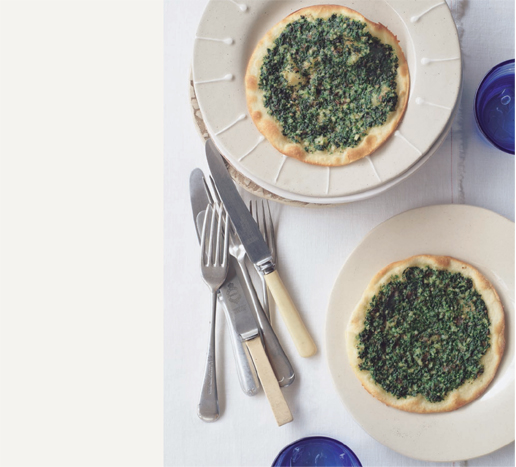
Haloumi, créme fraîche and spinach pizzas
550 g spinach leaves, washed
1 shallot, finely diced
1 small clove garlic, finely diced
finely grated zest of  lemon
lemon
½ teaspoon dried mint
150 g haloumi, washed and finely grated
60 ml créme fraîche
sea salt
freshly ground white pepper
1 quantity Turkish Pizza Dough
olive oil
Bring a large saucepan of salted water to the boil and blanch the spinach leaves in batches. Refresh in cold water, then squeeze firmly to extract as much liquid as you can.
Place the spinach on a large chopping board and put the shallot, garlic, zest and mint on top. Use a very large knife to chop and mix everything together as fine as you can get it until well combined. Tip the spinach mixture into a large bowl and stir in the haloumi and créme fraîche. Season with salt and pepper.
Preheat the oven to 220ºC. Knock back the dough, then tip it onto a lightly floured work surface. Divide the dough into 10 portions. Roll each portion into a round, 14 cm in diameter. Brush lightly with oil and spread with the spinach topping. Bake for 6–8 minutes (a fan-forced oven may take as little as 4–5 minutes) and serve piping hot.
MAKES 10
Pide – Turkish flat bread
We use this dough to make the soft, slightly chewy flat bread known throughout Australia as pide or Turkish bread. It’s typically shaped into a large rectangle or oval, and the top is marked with parallel rows of indentations and sprinkled with black nigella or sesame seeds. The same dough is used to make the long, open-faced pide pies, with all manner of savoury fillings.
1 tablespoon (2 x 7 g sachets) dried yeast
pinch of caster sugar
375 ml warm water
480 g strong bread flour
1 teaspoon salt
60 ml extra-virgin olive oil
2 free-range eggs
50 ml milk
nigella or sesame seeds
Dissolve the yeast and sugar in 125 ml of the warm water and set aside in a warm place for about 10 minutes until frothy. Use your fingers to work 90 g of the flour into the yeast to make a sloppy paste. Sprinkle lightly with a little more flour, then cover with a tea towel and set aside in a warm place for 30 minutes to form a ‘sponge’.
Put the remaining flour and the salt into a large bowl. Make a well in the centre and add the sponge, oil and remaining water. Use your fingers to work it to a soft, sloppy dough. Don’t panic: it is meant to be very sticky!
Transfer to an electric mixer fitted with a dough hook and knead on a low speed for 10–15 minutes until very smooth and springy. Transfer to a lightly oiled bowl, then cover with a damp tea towel and leave to rest at room temperature for 1 hour or until doubled in size. (From this point you can proceed to bake the pide bread or filled pide boats. You can also refrigerate the dough until you are ready to use it. It will keep for around 24 hours, but take it out of the refrigerator a good 3 hours before you want to use it, to give it time to return to room temperature slowly.)
When ready to bake the bread, preheat the oven to its highest setting with two pizza stones or oiled baking sheets in it. Divide the dough in two, then form into rounds and leave, covered, to rest for 30 minutes.
Mix the eggs and milk to make an egg wash. Place the dough on a lightly floured work surface. Use the heels of your hands to press and flatten each piece of dough out to a 20 cm oval. Brush the surface liberally with the egg wash. Dip your fingertips into the egg wash and mark rows of deep indentations across and down the length of the dough, leaving a narrow border.
Now comes the tricky bit. Lightly flour the hot pizza stones or trays. Lift on the pides, stretching them gently and evenly. Sprinkle with nigella or sesame seeds and bake for 8–10 minutes until crisp and golden brown.
MAKES 2
Cheese, egg and onion pide pies
The addition of an egg makes these pide pies wonderfully filling. Make an indentation along the length of the topping and allow the egg to run along it – this will ensure it cooks more evenly.
1 quantity Pide dough (opposite)
250 g haloumi, washed and finely sliced
150 g mozzarella, finely sliced
1 heaped teaspoon ground sumac
½ teaspoon freshly ground black pepper
½ teaspoon dried mint
4 shallots, finely sliced
1 tablespoon extra-virgin olive oil
1 free-range egg yolk
50 ml milk
6 free-range eggs
sea salt
Cut the dough into six even portions and leave, covered, to rest for 30 minutes.
When ready to bake the pide, preheat the oven to its highest setting with two pizza stones or oiled baking sheets in it.
To make the topping, mix the cheeses, spices, mint, shallots and oil in a large bowl.
Roll each portion of dough on a lightly floured work surface to form a long rectangle, around 35 x 10 cm. Scatter a sixth of the cheese topping down the pide, leaving a 2 cm border around the edge. Make a shallow indentation in the topping down the middle of each pide. Quickly fold up the two long sides of the dough, bringing them up and over the topping, but without meeting in the middle. Squeeze the sides together at each end, twisting slightly, so that the pide looks like a long canoe. Mix the egg yolk and milk to make an egg wash, then brush the dough with a little of this. Carefully transfer two pides to the hot stones or trays and bake for 5 minutes.
Crack one of the eggs into a small bowl and break the yolk. When the 5 minutes is up, open the oven door and carefully slip the egg into one of the pides so it runs naturally along the length of the indentation. Repeat with the other pide. Bake for a further 2 minutes. Bake the remaining pides in two batches, repeating the step with the eggs. Eat hot from the oven sprinkled with a little sea salt.
MAKES 6
Spinach, raisin and fetta pide pies
Spinach and fetta is a classic combination, but the addition of raisins adds a sweet dimension that I love.
1 quantity Pide dough
 cup raisins, roughly chopped
cup raisins, roughly chopped
250 g spinach leaves, washed
1 clove garlic
1 teaspoon sea salt
1 shallot, finely sliced
½ teaspoon ground nutmeg
½ teaspoon freshly ground black pepper
finely grated zest of ½ lemon
2 tablespoons extra-virgin olive oil
150 g fetta, roughly crumbled
1 free-range egg yolk
50 ml milk
Cut the dough into six even portions and leave, covered, to rest for 30 minutes.
Soak the raisins in a little water for 15 minutes, then drain. Meanwhile, bring a large saucepan of salted water to the boil and blanch the spinach in batches. Refresh in cold water, then squeeze firmly to extract any liquid.
When ready to bake the pide, preheat the oven to its highest setting with two pizza stones or oiled baking sheets in it.
To make the topping, crush the garlic with the salt and mix with the raisins, spinach, shallot, spices, zest, oil and all but 30 g of the fetta in a large bowl.
Roll each portion of dough on a lightly floured work surface to form a long rectangle, around 35 x 10 cm. Scatter a sixth of the topping down the pide, leaving a 2 cm border. Quickly fold up the two long sides of the dough, bringing them up and over the topping, but without meeting in the middle. Squeeze the sides together at each end, twisting slightly, so that the pide looks like a long canoe. Mix the egg yolk and milk to make an egg wash, then brush the dough with a little of this. Dot the open surface of each pide with some reserved fetta. Bake in batches, two at a time – carefully transfer the pides to the hot stones or trays and bake for 7 minutes. Eat hot from the oven.
MAKES 6
Cheese, sucuk and olive pide pies
Sucuk is a spicy Turkish sausauge and can be found in Turkish or Middle Eastern butchers and some specialist delis.
1 quantity Pide dough
250 g haloumi, washed and finely sliced
150 g mozzarella, finely sliced
18 kalamata olives, pitted and cut in half
1 long green pepper, seeded and chopped
2 tablespoons extra-virgin olive oil
sea salt
freshly ground black pepper
120 g sucuk, sliced
1 free-range egg yolk
50 ml milk
Cut the dough into six even portions and leave, covered, to rest for 30 minutes. When ready to bake the pide, preheat the oven to its highest setting with two pizza stones or oiled baking sheets in it.
To make the topping, mix the cheeses, olives, green pepper and oil in a large bowl, then season with salt and pepper. Roll each portion of dough on a lightly floured work surface to form a long rectangle, around 35 x 10 cm. Scatter a sixth of the topping down the pide, leaving a 2 cm border around the edge. Lie some of the sucuk down the centre, then quickly fold up the two long sides of the dough, bringing them up and over the topping, but without meeting in the middle. Squeeze the sides together at each end, twisting slightly, so that the pide looks like a long canoe.
Mix the egg yolk and milk to make an egg wash, then brush the dough with a little of this. Bake in batches, two at a time – carefully transfer the pides to the hot stones or trays and bake for 7 minutes. Eat hot from the oven sprinkled with a little sea salt.
MAKES 6

Cheese, Sucuk and Olive Pide Pie
Gruyére and spinach gözleme
In markets and villages, especially in the summer months, you’ll see women in traditional garb sitting cross-legged at low, broad tables rolling out large thin rounds of yufka dough. These are then stuffed and folded, oiled and cooked on a flat griddle to make gözleme, a famous Turkish snack. Hot and oozing with melted cheese, they are irresistible.
Gözleme are popular all around the country, although there can be some regional variations in the filling – I offer three of my own favourite fillings here.
Yufka pastry requires great skill and patience to make but thankfully is available ready made from Middle Eastern food stores.
550 g spinach leaves, washed
1 shallot, finely diced
1 small clove garlic, finely diced
sea salt
freshly ground white pepper
2 sheets yufka pastry
200 g gruyére, finely grated
melted unsalted butter
Bring a large saucepan of salted water to the boil and blanch the spinach leaves in batches. Refresh in cold water, then squeeze firmly to extract as much liquid as you can. Place the spinach on a large chopping board and put the shallot and garlic on top. Use a very large knife to chop and mix everything together until well combined. Season with salt and pepper.
Open out a sheet of yufka pastry so you have a large round on your work surface. Use a sharp knife to cut the pastry in half, then cut each half into three equal wedges. Stack them on top of each other and trim the curved edge straight. Repeat with the other sheet of pastry so you have a total of 12 small equilateral triangles.
Working with one triangle of pastry at a time, smear a generous tablespoon of the spinach mixture into the middle of the triangle, leaving a border around the edge. Top with some of the cheese, then brush a little melted butter on the triangle’s points and fold in the points to form a small enclosed triangle. Repeat until all the pastry, filling and cheese have been used.
Heat a heavy non-stick frying pan over a medium heat. Brush the gözleme with a little more melted butter and fry for 2–3 minutes, turning once. Serve hot from the pan.
MAKES 12
Fetta and dill gözleme
Fetta and dill is a popular filling for gözleme, but you could also use ricotta or curd cheese instead of fetta for a milder flavour.
250 g fetta, grated
1 free-range egg, lightly beaten
1 shallot, finely diced
1 small clove garlic, finely diced
½ cup chopped dill
sea salt
freshly ground white pepper
2 sheets yufka pastry
melted unsalted butter
Mix the fetta, egg, shallot, garlic and dill in a large bowl, then season with salt and pepper.
Open out a sheet of yufka pastry so you have a large round on your work surface. Use a sharp knife to cut the pastry in half, then cut each half into three equal wedges. Stack them on top of each other and trim the curved edge straight. Repeat with the other sheet of pastry so you have a total of 12 small equilateral triangles.
Working with one triangle of pastry at a time, smear a generous tablespoon of the fetta mixture into the middle of the triangle, leaving a border around the edge. Brush a little melted butter on the triangle’s points, then fold in the points to form a small enclosed triangle. Repeat until all the pastry and filling have been used.
Heat a heavy non-stick frying pan over a medium heat. Brush the gözleme with a little more melted butter and fry for 2–3 minutes, turning once. Serve hot from the pan.
MAKES 12
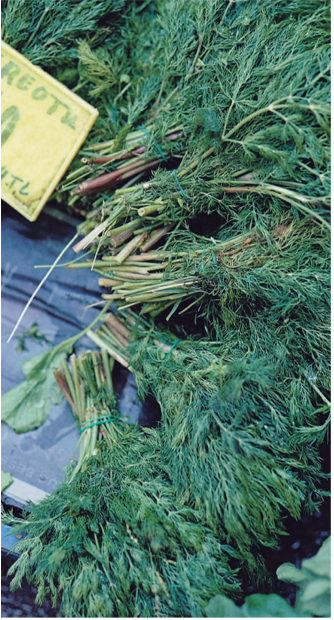
Pastirma and goat’s cheese gözleme
Yufka pastry is available from Turkish and Middle Eastern food stores. It generally comes in large pastry rounds, which can be cut or trimmed to size and shape. Traditionally gözleme are made as rectangular parcels, but I think these triangles are more fun.
2 sheets yufka pastry
240 g pastirma, very thinly sliced
220 g soft goat’s cheese, crumbled
1 tablespoon dried mint
1 teaspoon lemon zest
2 tablespoons extra-virgin olive oil
melted unsalted butter
Open out a sheet of yufka pastry so you have a large round on your work surface. Use a sharp knife to cut the pastry in half, then cut each half into three equal wedges. Stack them on top of each other and trim the curved edge straight. Repeat with the other sheet of pastry to total 12 small equilateral triangles.
Working with one pastry triangle at a time, arrange slices of pastirma in the centre of the triangle leaving a border around the edge. Scatter on the cheese and sprinkle with a little mint, lemon zest and oil. Brush some melted butter on the triangle’s points, then fold in the points to form a small enclosed triangle. Repeat until all the pastry, pastirma, cheese, mint and oil have been used.
Heat a heavy non-stick frying pan over a medium heat. Brush the gözleme with a little more melted butter and fry for 2–3 minutes, turning once. Serve hot from the pan.
MAKES 12
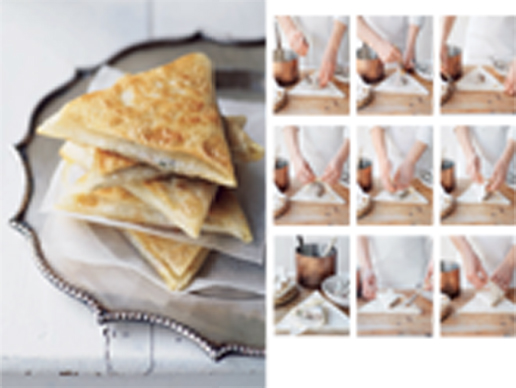
Yoghurt pastry
This is a wonderfully useful pastry that’s perfect for making all kinds of open tarts and savoury pastries. It’s soft, silky and easy to work with and bakes to a lovely short flakiness. The method below is a variation on a classic ‘rough-puff’; the brushing with butter, folding and turning create meltingly crisp layers.
Following this is a selection of börek recipes, all of which use this wonderful pastry.
100 g thick natural yoghurt
160 g melted unsalted butter (at room temperature)
1 tablespoon extra-virgin olive oil
1 free-range egg
220 g self-raising flour, sifted
pinch of sea salt
finely grated zest of ½ lemon
Combine the yoghurt, 125 g of the melted butter and the oil in the bowl of an electric mixer, then beat in the egg. Tip in the flour, salt and zest and beat on a low speed for 5 minutes until silky and soft. Cover the pastry with plastic wrap and refrigerate for 1 hour to rest and firm up a little.
Divide the pastry into two equal pieces. Work with one piece of pastry at a time, keeping the other covered with a damp tea towel. On a lightly floured work surface, roll the pastry out as thin as you can get it to make a large round – about 50 cm in diameter or as close to that as you can make it. Brush lightly with some of the remaining melted butter, then fold in two sides of the pastry to meet in the middle. Brush with butter again, then fold one side on top of the other, so you have a rectangle. Brush with butter again, then fold in the short sides of the rectangle to meet in the middle. Brush with butter for a final time and fold one side on top of the other. Set aside, covered with a damp tea towel, to rest for 15 minutes. Repeat with the other piece of dough.
MAKES 2 x 300 g pieces
Lamb and pine nut börek
The quantities given here will make four big börek, each of which will give about six slices. Serve as part of a mezze selection or as nibbles at a drinks party.
500 g minced lamb
1 small purple onion, finely chopped
1 clove garlic, finely chopped
1 tablespoon extra-virgin olive oil
¼ cup shredded flat-leaf parsley leaves
3 teaspoons Lamb Spice Mix
1 teaspoon sea salt
1 quantity (2 x 300 g pieces)
Yoghurt Pastry (opposite)
1 free-range egg yolk
50 ml milk
Preheat the oven to 170ºC and lightly grease a large baking sheet.
Combine the lamb, onion, garlic, oil, parsley, spice mix and salt in a bowl and use your hands to knead the mixture to a smooth, homogeneous paste.
Cut each piece of pastry in half so you have four portions. On a lightly floured work surface, roll out each piece of pastry to a large rectangle about 2 mm thick. Sprinkle a quarter of the filling over the long edge and roll up to form a long log. Pinch the short ends to seal. Repeat with the other pieces of pastry.
Transfer the four logs to the prepared baking sheets, seam-side down and with the sealed ends tucked underneath. Mix the egg yolk and milk to make an egg wash, then brush the pastry with this. Bake for 20 minutes until golden brown. Allow to cool a little, then cut each log into six slices, using a serrated knife, and serve immediately.
SERVES 6–8
Pumpkin and fetta börek
Pumpkin has a lovely sweetness to it, which melds beautifully with salty fetta. These vegetarian börek are lovely served with a salad of bitter greens and herbs, and a strong-flavoured dressing.
700 g butternut pumpkin, peeled and diced
20 g butter
1 small onion, finely diced
1 clove garlic, finely diced
½ teaspoon ground nutmeg
½ teaspoon freshly ground black pepper
½ teaspoon hot paprika
¼ cup shredded flat-leaf
parsley leaves
200 g fetta, roughly crumbled
2 free-range egg yolks
2 tablespoons milk
1 quantity (2 x 300 g pieces)
Yoghurt Pastry (opposite)
Preheat the oven to 180ºC and lightly grease 2 large baking sheets.
Steam the pumpkin for about 10 minutes until tender, then tip into a large bowl. Meanwhile, melt the butter in a heavy-based frying pan and sauté the onion and garlic for about 5 minutes, until soft and translucent. Add to the pumpkin with the spices, parsley and cheese and mash with a fork until very smooth.
Mix the egg yolks and milk to make an egg wash. Cut each piece of pastry into eight pieces (16 in total). On a lightly floured work surface, roll out each piece of pastry to a rectangle about 2 mm thick. Spread some of the filling down the middle, then fold in the long edges, sealing with a little egg wash. Pinch the short ends to seal. Repeat with the other pieces of pastry so you have 16 small pies. Transfer the pies to the prepared baking sheets, seam-side down. Brush with the egg wash and bake for 6–8 minutes or until golden brown.
MAKES 16
Spinach and cheese börek
You can really use any cheese with the spinach in these little pies. Kashkeval is a stongly flavoured, hard white sheep’s milk cheese that is fairly widely available in Middle Eastern stores, but you could equally use fetta, mozzarella or even a blue cheese.
550 g spinach leaves, washed
1 shallot, finely diced
1 small clove garlic, finely diced
sea salt
freshly ground white pepper
180 g kashkeval cheese, crumbled
2 free-range egg yolks
2 tablespoons milk
1 quantity (2 x 300 g pieces) Yoghurt Pastry
Preheat the oven to 180ºC and lightly oil 2 large baking sheets.
Bring a large saucepan of salted water to the boil and blanch the spinach leaves in batches. Refresh in cold water, then squeeze firmly to extract as much liquid as you can. Place the spinach on a large chopping board and put the shallot and garlic on top. Use a very large knife to chop and mix everything together until well combined. Season with salt and pepper. Transfer to a bowl and mix in the cheese.
Mix the egg yolks and the milk to make an egg wash. Cut each piece of pastry into eight pieces (16 in total). On a lightly floured work surface, roll out each piece of pastry to a rectangle about 2 mm thick. Spread some of the filling down the middle, then fold in the long edges, sealing with a little egg wash. Pinch the short ends to seal. Repeat with the other pieces of pastry so you have 16 small pies. Transfer the pies to the prepared baking sheets, seam-side down. Brush with the egg wash and bake for 6–8 minutes or until golden brown.
MAKES 16
Breads and pastries
Savoury pastries appear in a seemingly endless repertoire of shapes, sizes and fillings; made from either crisp wafer-thin yufka pastry, a type of flaky puff pastry, or denser yeast doughs, then fried or baked, or toasted on a hot griddle. Fillings can be anything from spicy minced meat, poultry or offal, lemony spinach or silverbeet, meltingly soft eggplant or tangy cheese. Favourite shapes are little triangles, cigars, crescents, rectangular parcels and little pies.
The Turkish fondness for breads and pastries has been passed down through many centuries. Historians suggest that the Turkic tribes of Central Asia knew how to cultivate wheat, and developed many of the techniques for making dough and cooking breads and pastries that are still used today.
Of the countless varieties of savoury breads and pastries made, it is the category known as börek that is most distinctly Turkish. Although the genealogy of börek isn’t clear, it is thought they evolved from Turkish flat breads. In the days before they had ovens, pastoral nomads cooked unleavened breads on assorted griddles. Layered pastries emerged as doughs were rolled ever thinner and then stuffed with all sorts of fillings to make a more satisfying snack or meal.
One of the more unusual members of the börek family is su börek (meaning water börek), which is closer to a lasagne than other baked or fried pastries we’d eaten. While in Turkey, we spent a wonderful afternoon with eminent local food writer Engin Akin in her sunny Istanbul home, learning the mysteries of making this legendary dish.
We watched Engin and her friends preparing egg-enriched pasta dough and using the traditional oklava – a special long, thin rolling pin – to roll it out as thinly as possible. The sheets of pasta were boiled in a massive pot of boiling salted water until soft, and then laid out to dry on a cloth. Engin has a large circular pan that she uses specially for making su börek. After brushing it with melted butter – not too much, Engin insisted – an initial layer of uncooked pastry was arranged in the pan, and six more cooked sheets layered on top. There are always seven sheets of pastry, Engin explained, one for each day of the week.
The filling that day was a mixture of white cheese and chopped parsley. Three buttered sheets of pastry were arranged on top of it and the pie was completed with a final uncooked pastry sheet. More melted butter was brushed over the top and the pastry sheets were tucked down the sides of the pan to make a neat pie. We were fascinated to see that Engin cooked her su börek on the stove top rather than in the oven. It was a very low flame, and required constant turning to achieve a crisp golden pie base. After about forty minutes, the base was ready and the whole thing was inverted in the pan to cook the top layer.
It did seem like a lot of effort. But then we sat down to eat the fruits of Engin’s labour. On the table were dishes of preserves: tiny wild figs, gleaming like bright green emeralds, and gorgeous amethyst plums, sugar-dense and dripping with syrup. Our hostess poured us glasses of chilled homemade lemonade, explaining that su börek is best accompanied by something sweet. Then the serving spoon broke through the crisp golden crust of the pie to reveal the silky-soft cheesy layers within, and after a few mouthfuls we understood that any resemblance to the humble lasagne was purely superficial. Here, perhaps, was the most sublime expression of the simple act of rolling out dough; an act that’s been refined through the centuries to achieve its zenith in su börek.
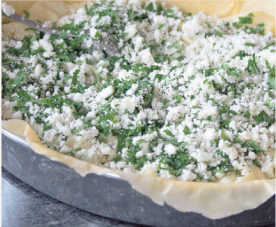
Börek ‘cigars’ with cheese
Cheese sigari or ‘cigars’ are nearly always offered as part of a mezze spread, and will often be served as a snack to eat with Turkish tea or ayran, a popular yoghurt drink. They are made with yufka pastry, which holds up well to deep-frying. Traditionally they are filled with fetta and flavoured with fresh dill or mint. I’ve used tarragon here, which adds a wonderful aniseed element that goes well with the goat’s cheese. Feel free to mix and match with your own choice of soft cheese and fresh herbs.
200 g soft goat’s cheese
1 small onion, grated
¼ cup chopped French tarragon
2 free-range eggs
sea salt
freshly ground black pepper
1 sheet yufka pastry
1 teaspoon extra-virgin olive oil
vegetable oil for deep-frying
Combine the cheese, onion, tarragon and one of the eggs in a bowl, then season with salt and pepper and mash thoroughly with a fork.
Open out the sheet of yufka pastry so you have a large round on your work surface. Use a sharp knife to cut the pastry in half, then cut each half into eight equal skinny triangles. Stack them on top of each other and trim the curved edge straight. You should have a total of 16 triangles.
Work with one triangle at a time, with the point facing away from you. Place a spoonful of filling at the base of the triangle and fold the corners in and over it. Roll the pastry and filling up like a cigar, moistening the end with a little water to help seal it. Repeat until all the pastry and filling have been used. Lightly beat the remaining egg with the extra-virgin olive oil and brush each rolled börek with a little of this egg wash.
Heat the oil in a small saucepan or deep-fryer to 200ºC. Fry the börek a few at a time for 2–3 minutes, or until golden brown. Remove with a slotted spoon to drain on kitchen paper and keep warm while you fry the remaining börek.
MAKES 16
Börek ‘cigars’ with brains
The creamy texture of poached brains makes a surprising and wonderful filling for crisp, golden börek ‘cigars’.
4 sets of lamb’s brains
milk
1 lemon, cut into quarters
1 stick cinnamon
4 cloves
½ onion
1 litre water
20 g unsalted butter
2 shallots, finely diced
1 clove garlic, finely diced
1 teaspoon dried mint
½ teaspoon freshly ground black pepper
100 g mozzarella
150 g haloumi, washed
 cup shredded flat-leaf parsley leaves
cup shredded flat-leaf parsley leaves
finely grated zest of ½ lemon
½ teaspoon ground nutmeg
½ teaspoon sea salt
1 free-range egg yolk
1 sheet yufka pastry
1 free-range egg
1 teaspoon extra-virgin olive oil
vegetable oil for deep-frying
Soak the lamb’s brains in cold, salted water overnight, or in milk for 2 hours.
Place the lamb’s brains in a large saucepan with the lemon, cinnamon, cloves, onion and water. Bring to the boil, then skim and simmer for 2 minutes. Remove the pan from the heat and allow the brains to cool in the liquid. When they are cold, remove them from the pan and split each set in half. Pat dry, then cut into 1 cm dice.
Melt the butter in a heavy-based frying pan and sweat the shallots and garlic for 5 minutes until soft and translucent, then stir in the mint and pepper. Tip the mixture into a bowl and leave to cool. Stir in the brains, cheeses, parsley, zest, nutmeg, salt and egg yolk.
Open out the sheet of yufka pastry so you have a large round on your work surface. Use a sharp knife to cut the pastry in half, then cut each half into eight equal skinny triangles. Stack them on top of each other and trim the curved edge straight. You should have a total of 16 triangles.
Work with one triangle at a time, with the point facing away from you. Place a spoonful of filling at the base of the triangle and fold the corners in and over it. Roll the pastry and filling up like a cigar, moistening the end with a little water to help seal it. Repeat until all the pastry and filling have been used. Lightly beat the egg with the extra-virgin olive oil and brush each rolled börek with a little of this egg wash.
Heat the oil in a small saucepan or deep-fryer to 200ºC. Fry the börek a few at a time for 2–3 minutes, or until golden brown. Remove with a slotted spoon to drain on kitchen paper and keep warm while you fry the remaining börek.
MAKES 16
Circassian puf börek with cheese and dill
‘Puf’ börek are typically crescent-shaped and deep-fried to a crisp golden brown. They melt almost to nothing in your mouth, and make a perfect nibble to eat with a few glasses of icy cold raki.
If you are concerned about your waistline, then these börek can also be baked. The result will be somewhat different – the pastry short and flaky, and somehow more substantial – but just as delicious.
200 g fetta
½ cup finely grated parmesan
1 small onion, grated
 cup chopped dill
cup chopped dill
1 free-range egg
1 tablespoon extra-virgin olive oil
finely grated zest of ½ lemon
½ teaspoon freshly ground black pepper
1 quantity (2 x 300 g pieces) Yoghurt Pastry
vegetable oil for deep-frying
Combine the cheeses, onion, dill, egg, extra-virgin olive oil, zest and pepper in a large bowl and mash with a fork until very smooth.
Cut each piece of pastry into five pieces (10 in total). On a lightly floured work surface, roll each piece of pastry out to a rough round, about 20 cm in diameter and 2 mm thick. Use a 9 cm pastry cutter to cut out three rounds from each piece of pastry. Place a teaspoon of filling into the middle of each round, then brush the edge with a little water and fold the top over to create a crescent. Press gently to seal. Cover the börek with a damp tea towel as they are completed. You should be able to make around 30.
Heat the vegetable oil in a saucepan or deep-fryer to 180ºC. Fry two or three börek at a time. After a few seconds they will puff up and rise to the surface – use a slotted spoon to turn them continuously in the hot oil. When golden brown remove to drain on kitchen paper. (If you prefer to bake the börek, arrange them on a lightly oiled baking sheet and bake in an oven, preheated to 180ºC, for 10–12 minutes, or until golden brown.) Serve hot.
MAKES 30
